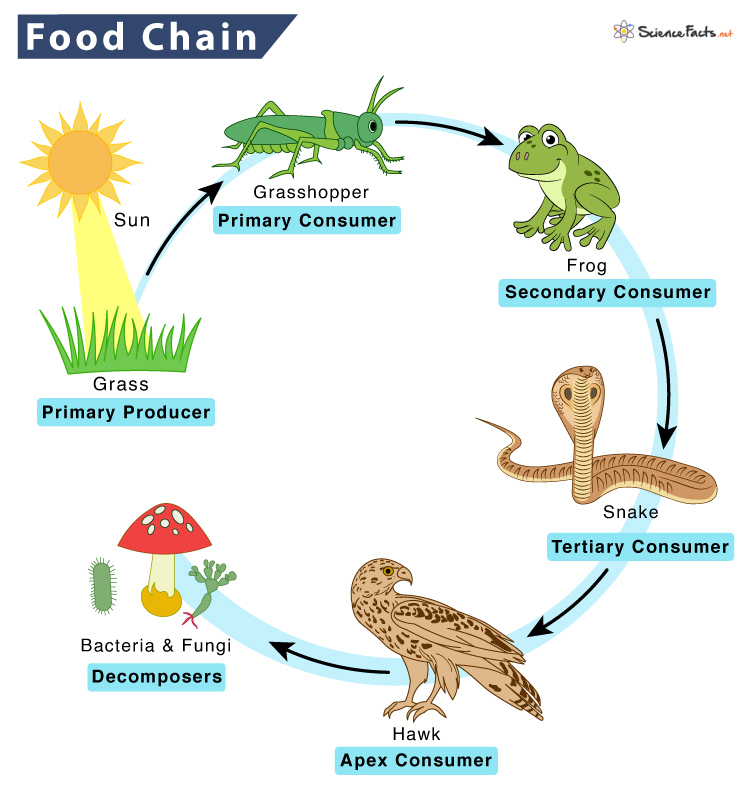Food Chain
All plant and animal species depend partially or totally on another plant or animal for their food. For example – grass grows due to sunlight, deer eats the grass, and tiger eats the deer. When the tiger dies, bacteria decompose its body, returning the dead organic matter to the soil, which provides nutrients for the grass to grow.
What is a Food Chain
A food chain refers to a linear sequence of organisms showing how energy or nutrient flows through an ecosystem when one organism consumes another for its survival. It provides information about which species eats which other species in nature. Typically, a food chain is represented by a diagram where arrows show the direction of energy and nutrients flow.
Many herbivores eat grass, and deer can eat other plants besides grass. Even a tiger can eat many types of animals and plants. Thus, each animal is part of multiple food chains. All interconnected to make a food web.
Trophic Levels
Organisms in the food chain are divided into trophic levels or feeding levels. The four essential parts are the sun, primary producers, consumers, and decomposers. Every food chain originates with the sun providing light and energy for plants to grow and ends with the decomposition of the animals.
The different trophic levels in a typical food chain are:
Primary Producers
They are the first biotic factor occupying the first tropic level or the bottom of the food chain. Primary producers mainly produce their own food by photosynthesis or chemosynthesis. Plants, algae, and autotrophic bacteria are primary producers.
Consumers
They occupy the food chain’s second, third, and fourth trophic levels.
- The organisms that depend on primary producers for food are primary consumers. Insects, flies, and some birds and animals are primary consumers. Primary consumers are grasshoppers, caterpillars, rabbits, hummingbirds, cows, sheep, deer, and goats. Animals that feed on grass and plants are called herbivores.
- The organisms that feed on the primary consumers are secondary consumers. They are primarily meat-eaters such as foxes, wolves, owls, hawks, and eagles are called carnivores. However, smaller animals like spiders, frogs, lizards, moles, and small birds like kingfisher are also part of this trophic level.
- Finally, the organisms that depend on the secondary consumers for their food are tertiary consumers. They can be carnivores (meat-eaters) or omnivores (plants and meat-eaters). Large animals like leopards, seals, sea lions and sharks are examples of tertiary consumers. Small reptiles like snakes are also a part of this trophic level. Tertiary consumers that do not have any natural predators sit at the top of the food chain.
Since secondary and tertiary consumers hunt their food, they are called predators. Some food chains contain additional trophic levels like quaternary consumers that feed on tertiary consumers. They are also called apex consumers or apex predators. These include lions, tigers, grizzly bears, polar bears, killer whales (orcas), giant snakes, golden eagles, and harpy eagles.
Decomposers
They are organisms that break down dead organic materials and wastes from other tropic levels. Decomposers include microorganisms such as bacteria and fungi that consume dead remains of plants or animals, including humans. Thus, the level of decomposers in the food chain runs parallel to primary, secondary, and tertiary consumers.
Some decomposers are detritivores – debris eaters that are multicellular organisms such as earthworms, crabs, slugs, or vultures. They feed on dead organic matter, producing debris, and making it more available for bacterial or fungal decomposers. Decomposers complete the food chain and are essential to keeping the ecosystem healthy. When they break down dead material and wastes, they release nutrients to the soil for use by autotrophs, which can start a new food chain.
The overall steps of a food chain in order are:
Sun -> Primary Producers -> Primary Consumers -> Secondary Consumers -> Tertiary Consumers
Types of Food Chain
There are two types of food chains:
1. Grazing food chain starts with green plants, followed by herbivores and carnivores. Here, the energy in the lowest trophic level is obtained from photosynthesis. As autotrophs are at the base of all ecosystems on Earth, most ecosystems are of this kind.
A typical example is phytoplanktons eaten by zooplankton, which small fishes eat, and then large fishes eat small fishes.
A grazing food chain can be either predator or a parasitic type. In a predator grazing food chain, one animal consumes another animal. The animal that is eaten is known as the prey, and the animal that eats is called the predator. In contrast, plants and animals are infected by parasites in a parasitic grazing food chain.
2. Detritus food chain begins with dead organic matter of plants and animals. Decomposers and detritivores such as fungi, bacteria, and protozoans feed on them. Then, the decomposers are eaten by smaller carnivores like maggots. Finally, the smaller carnivores are eaten by larger carnivores like frogs and snakes.
Thus, the food chain study is essential as they show how an organism depends on another organism in an ecosystem for its survival. It also shows the path of energy flow inside an ecosystem.
FAQs
Ans. Mushrooms are decomposers that use dead and decaying material to gain energy and help to recycle nutrients back into the food chain and thus are essential to the food chain.
Ans. Food chains are short at each trophic level because lesser energy is available to animals at each successive level of the food chain.
Ans. Most food chains did not have a fourth trophic level because the energy at each successive trophic level is lost due to life processes and waste.
Ans. No, food chains are not an accurate representation of energy flow in an ecosystem. Natural ecosystems are much more complex than simplified food chains.
Ans. Most of the energy in a food chain is lost as metabolic heat.
-
References
Article was last reviewed on Friday, February 17, 2023





Nice description of the different parts of the food chain!